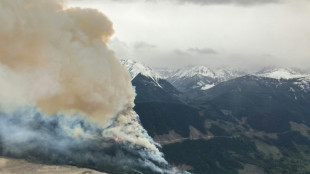
-
 What's the fallout of Mexican drug lords' capture?
What's the fallout of Mexican drug lords' capture?
-
Video game makers see actors as AI 'data,' says union on strike

-
 Chinese qualifier Shang to face Thompson in ATP Atlanta semis
Chinese qualifier Shang to face Thompson in ATP Atlanta semis
-
'Massive attack' on French rail threatens more chaos

-
 'We did it!': France breathes sigh of relief after Olympics ceremony
'We did it!': France breathes sigh of relief after Olympics ceremony
-
Regional concern grows as Venezuela blocks vote observers

-
 Historic river parade, Dion show-stopper ignite Paris Olympics
Historic river parade, Dion show-stopper ignite Paris Olympics
-
Rainy Paris Olympic parade dampens many spectators' spirits

-
 The one of a kind Paris opening ceremony: five memorable moments
The one of a kind Paris opening ceremony: five memorable moments
-
Justin Timberlake seeks to dismiss DUI case

-
 Warner Brothers Discovery sues NBA over Amazon rights deal
Warner Brothers Discovery sues NBA over Amazon rights deal
-
Kobe Bryant locker, Maradona jersey up for auction in New York

-
 Historic river parade launches Paris Olympics
Historic river parade launches Paris Olympics
-
New York family of Holocaust victim reclaims Nazi-looted art

-
 NASA Mars rover captures rock that could hold fossilized microbes
NASA Mars rover captures rock that could hold fossilized microbes
-
Thousands evacuate season's biggest wildfire in northern California

-
 Ethiopia mourns victims of landslide tragedy
Ethiopia mourns victims of landslide tragedy
-
Lady Gaga adds sparkle to star-studded Olympic show

-
 Airbus and Boeing supremacy secure despite turbulence
Airbus and Boeing supremacy secure despite turbulence
-
Teams sail down Seine in rain-soaked Olympics opening ceremony

-
 West Indies' treble strike rocks England in third Test
West Indies' treble strike rocks England in third Test
-
Olympic opening ceremony under way on River Seine

-
 Mott's England future uncertain as ECB chief fails to offer support
Mott's England future uncertain as ECB chief fails to offer support
-
Trump meets Israeli PM Netanyahu in Florida

-
 S.African police say 95 Libyans detained at suspected military camp
S.African police say 95 Libyans detained at suspected military camp
-
Blinken set for talks with Chinese counterpart in Laos

-
 Norris heads Piastri in McLaren one-two at Belgian GP practice
Norris heads Piastri in McLaren one-two at Belgian GP practice
-
G20 seeks common ground on taxing super-rich

-
 European medicines watchdog rejects new Alzheimer's drug
European medicines watchdog rejects new Alzheimer's drug
-
Habib, Ebden eye Alcaraz and Djokovic shocks at Olympics tennis

-
 Long queues, ticketing problems ahead of Paris opening ceremony
Long queues, ticketing problems ahead of Paris opening ceremony
-
Two Sinaloa Cartel leaders face US charges after stunning capture

-
 Spain train driver jailed for 2.5 years over deadly 2013 crash
Spain train driver jailed for 2.5 years over deadly 2013 crash
-
Paris poised for Olympic opening ceremony spectacular

-
 Judoka fails doping test in first case at Paris Olympics
Judoka fails doping test in first case at Paris Olympics
-
Holder and Da Silva keep England at bay after West Indies collapse

-
 Alpine F1 boss Bruno Famin to leave in August
Alpine F1 boss Bruno Famin to leave in August
-
Ethiopia declares three days of mourning after landslide tragedy

-
 Brazilian dunes dotted with dazzling pools make UNESCO heritage list
Brazilian dunes dotted with dazzling pools make UNESCO heritage list
-
Rain, cooling slow huge blaze in Canada's Jasper park

-
 French Rugby's Jaminet suspended 34 weeks after racist video: Federation
French Rugby's Jaminet suspended 34 weeks after racist video: Federation
-
Osaka looking to turbo-charge comeback at Paris Olympics

-
 Russian central bank hikes key rate to fight inflation
Russian central bank hikes key rate to fight inflation
-
Verstappen tops times in opening practice, faces grid penalty

-
 UK to reveal £20 bn hole in public finances: reports
UK to reveal £20 bn hole in public finances: reports
-
Gaming sector recovery on flamboyant display at ChinaJoy expo

-
 Biles ready to unveil unique uneven bars skill at Paris Olympics
Biles ready to unveil unique uneven bars skill at Paris Olympics
-
Players unaware of spying scandal as Canada Olympic coach sent home: official

-
 Snoop Dogg stars as flame sails into Paris for opening ceremony
Snoop Dogg stars as flame sails into Paris for opening ceremony
-
US Fed's favored inflation measure cools further in June


Libya's Sirte - from Kadhafi to the jihadist IS
Forces allied with Libya's unity government are closing in on Islamic State group fighters in Sirte in a month-long operation aimed at ousting the jihadists from their North African stronghold.
Here is some background on Sirte and its fall to IS.
Strategic importance
Sirte is on the Mediterranean coast roughly half way between Libya's capital Tripoli in the west and Benghazi in the east.
A major port city, it lies just 350 kilometres (220 miles) from the Italian coast.
It is also a mere 150 kilometres west of Libya's main oil-producing area and export terminals.
Oil is a vital source of income for Libya, and several groups have fought to control its wells and pipelines since the fall of Moamer Kadhafi in 2011. The IS presence in Sirte had raised fears it would attempt to seize the fields to fund its North Africa operations.
Population
Sirte used to have around 120,000 residents, most of them in the city centre or spread along the coast.
All but around 30,000 have fled since IS took over in June last year, a spokesman for pro-government forces, Reda Issa, told AFP.
Most people in Sirte belong to three major tribes including the Kadhadfa tribe of Kadhafi.
Infrastructure
Sirte has a large port, an international airport and an important military base. It also hosts one of North Africa's largest conference venues, the Ouagadougou conference centre which IS militants have been using as a command centre.
Kadhafi era
The home town of the former dictator, Sirte had a privileged position in Libya during his four-decade rule, not least because many residents belonged to the Kadhadfa tribe.
Post-Kadhafi
Sirte suffered major damage during the 2011 uprising.
Kadhafi loyalists used the city as a base to attack rebels in both the west and the east.
The dictator himself fled there after Tripoli fell to rebels at the end of August 2011. After Sirte also fell, gunmen tracked him down and killed him.
Sirte paid the price for supporting the regime. Heavy fighting destroyed entire streets. Residents accuse post-Kadhafi authorities of marginalising them in revenge for the dictator's rule.
Jihadist takeover
IS announced on June 9 last year it had captured Sirte. It has used it as a rear base, training foreign fighters to carry out operations overseas.
It hung its flags along the main streets, forced people to pray five times a day and banned women from leaving home without a male chaperone.
The group ruled Sirte through fear, brutally punishing dissent.
In May, Human Rights Watch said IS had beheaded or shot at least 49 people in Sirte for alleged crimes including blasphemy, sorcery and spying.
Forces loyal to the UN-backed Government of National Accord have been closing in on IS in the city since the operation began in mid-May.
IS forces are holed up in a dense residential district near the city centre, suggesting that the battle has become a street fight that could devastate the city even further.
E.Borba--PC
